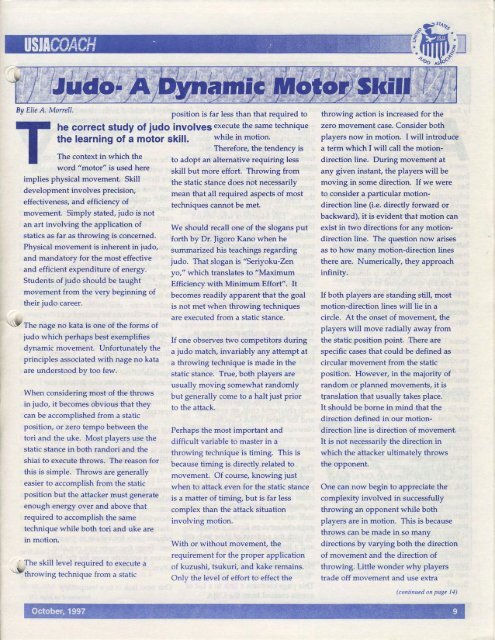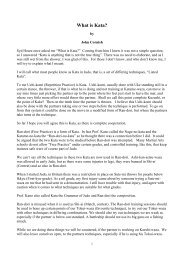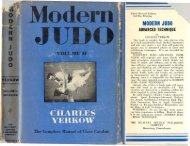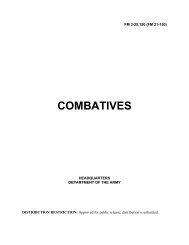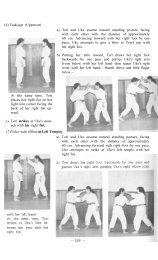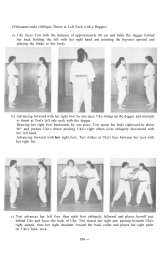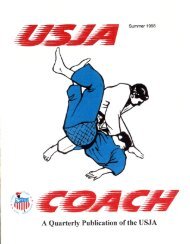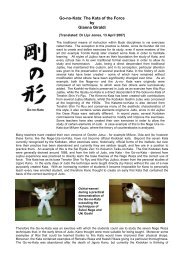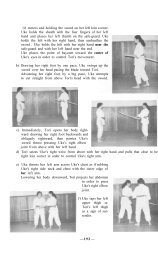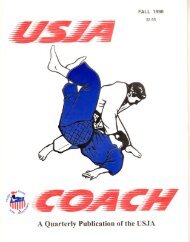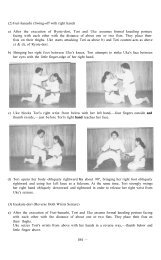USJA Coach - Judo Information Site
USJA Coach - Judo Information Site
USJA Coach - Judo Information Site
- No tags were found...
Create successful ePaper yourself
Turn your PDF publications into a flip-book with our unique Google optimized e-Paper software.
By EIie A. MoneILposition is far less than that required tohe COrfeCt StUdy Of jUdO inVOlVeS execute the same techniquewhile in motion.The context in which theword "motor" is used hereimplies physical movement. Skilldevelopment involves precision,effectiveness, and efficiency ofmovement. Simply stated, judo is notan art involving the application ofstatics as far as throwing is concerned.Physical movement is inherent in judo,and mandatory for the most effectiveand efficient expenditure of energy.Students of judo should be taughtmovement from the very beginning oftheir judo career.'{}Th" nage no kata is one of the forms ofjudo which perhaps best exemplifiesdynamic movement. Unfortunately theprinciples associated with nage no kataare understood by too few.When considering most of the throwsin judo, it becomes obvious that theycan be accomplished from a staticposition, or zero tempo between thetori and the uke. Most players use thestatic stance in both randori and theshiai to execute throws. The reason forthis is simple. Throws are generallyeasier to accomplish from the staticposition but the attacker must generateenough energy over and above thatrequired to accomplish the sametechnique while both tori and uke arein motion.the learning of a motor skill..' The skill level required to execute aJthro*ingtechnique from a staticto adopt an alternative requiring lessskill but more effort. Throwing fromthe static stance does not necessarilymean that all required aspects of mosttechniques cannot be met.We should recall one of the slogans putforth by Dr. Jigoro Kano when hesummarized his teachings regardingjudo. That slogan is "Seriyoku-Zenyo," which translates to "MaximumEfficiency with Minimum Effort". Itbecomes readily apparent that the goalis not met when throwing techniquesare executed from a static stance.If one observes two competitors duringa judo match, invariably any attempt ata throwing technique is made in thestatic stance. True, both players areusually moving somewhat randomlybut generally come to a halt just priorto the attack.Perhaps the most important anddifficult variable to master in athrowing technique is timing. This isbecause timing is directly related tomovement. Of course, knowing justwhen to attack even for the static stanceis a matter of timing, but is far lesscomplex than the attack situationinvolving motion.Therefore, the tendency isWith or without movement, therequirement for the proper applicationof kuzushi, tsukuri, and kake remains.Only the level of effort to effect thethrowing action is increased for thezero movement case. Consider bothplayers now in motion. I will introducea term which I will call the motiondirectionline, Dtuing movement atany given instant, the players will bemoying in some direction. If we wereto consider a particular motiondirectionline (i.e. directly forward orbackward), it is evident that motion canexist in two directions for any motiondirectionline. The question now arisesas to how many motion-direction linesthere are. Numerically, they approachinfinity.If both players are standing still, mostmotion-direction lines will lie in acircle. At the onset of movemenL theplayers will move radially away fromthe static position point. There arespecific cases that could be defined ascircular movement from the staticposition. However, in the majority ofrandom or planned movements, it istganslation that usually takes place.It should be bome in mind that thedirection defined in our motiondirectionline is direction of movement.It is not necessarily the direction inwhich the attacker ultimatelv throwsthe opponent.One can now begin to appreciate thecomplexity involved in successfullythrowing an opponent while bothplayers are in motion. This is becausethrows can be made in so manydirections by varying both the directionof movement and the direction ofthrowing. Little wonder why playerstrade off movement and use extra(continued on page 14)


